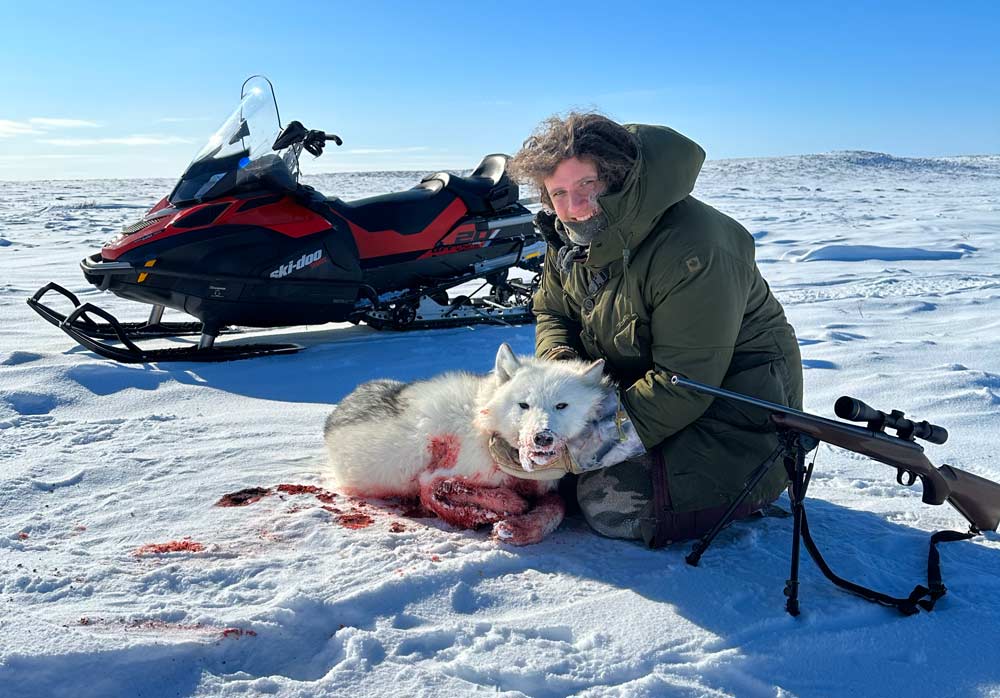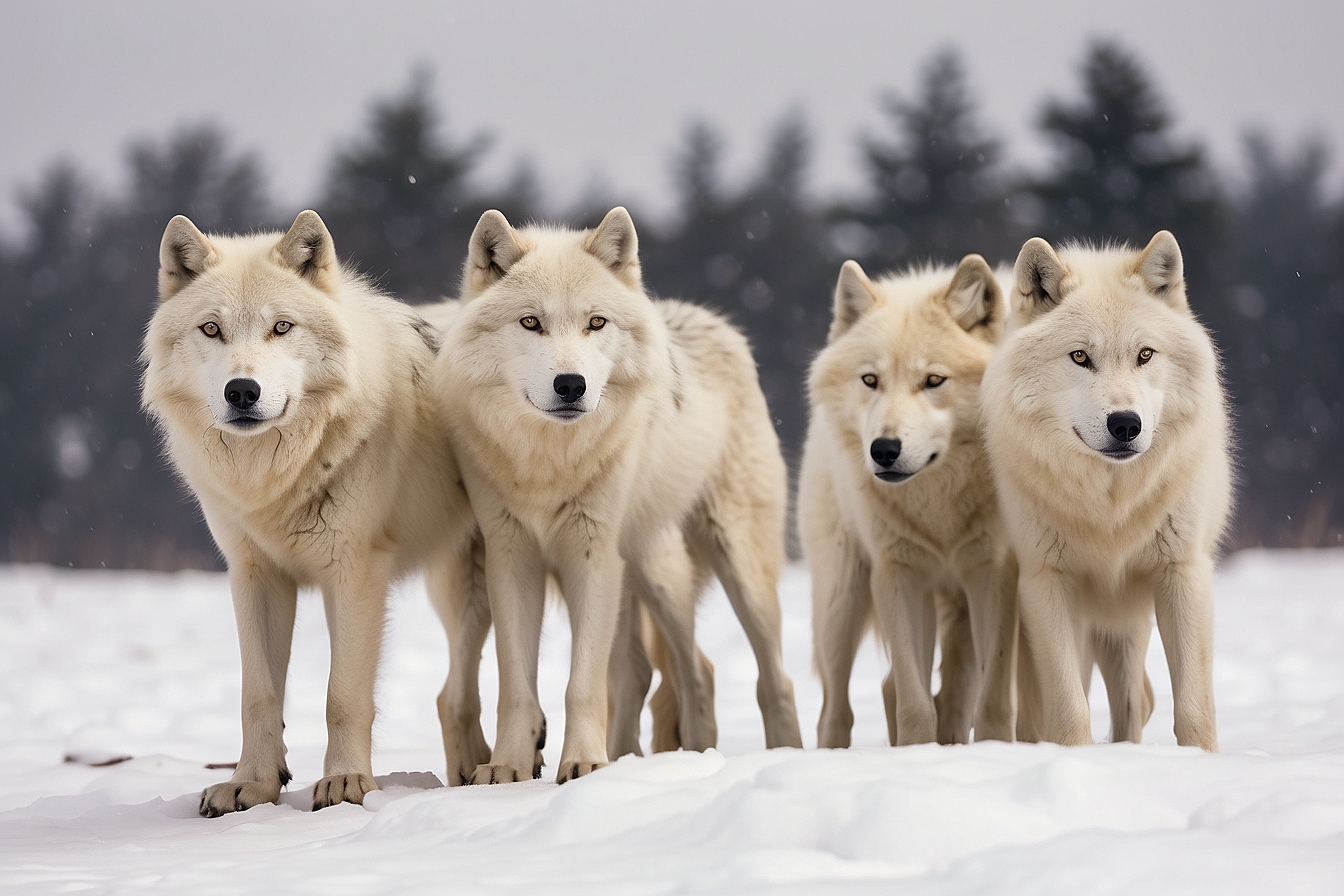Introduction

The Arctic wolf (Canis lupus arctos), also known as the white wolf, is a subspecies of the gray wolf native to the High Arctic regions of Canada, Alaska, and Greenland. Renowned for its stunning white fur and remarkable adaptations to extreme cold, the Arctic wolf offers one of the most challenging and rewarding hunting experiences in the world.
Habitat and Adaptations
Arctic wolves inhabit the northernmost parts of the Arctic Archipelago, including Ellesmere and Axel Heiberg Islands. Their thick white fur provides camouflage against the snowy landscape and insulation against temperatures that can plummet below -30°C (-22°F). These wolves have smaller ears and shorter noses compared to other gray wolves, minimizing heat loss. Their paws are also fur-covered, acting like natural snowshoes and providing traction on icy surfaces.
Behavior and Diet
Living in small family packs, Arctic wolves primarily hunt muskoxen and Peary caribou. They are opportunistic feeders, also preying on Arctic hares, seals, waterfowl, ptarmigans, and lemmings. Unlike other wolves, Arctic wolves do not fear humans, often approaching them out of curiosity.
Hunting the Arctic Wolf: A Unique Challenge

Hunting Seasons and Methods
Arctic wolf hunts typically occur from late February to May. Hunters often travel by snowmobile and sled, guided by experienced Inuit trackers, to locate fresh wolf sign. The hunts are conducted on the mainland and remote Arctic islands, with accommodations ranging from heated wall tents to basic cabins.
Cost of Arctic Wolf Hunts
The cost of hunting an Arctic wolf varies depending on the outfitter and package. For instance, Steve’s Outdoor Adventures offers Arctic wolf hunting packages ranging from $9,500 to $12,500. Similarly, BlueSky Outfitting lists their Arctic wolf hunts at $9,500 plus GST, with additional fees for second wolves and other species.
🐕 Arctic Wolf and Husky Mix: The Siberian Husky Connection
The Siberian husky Arctic wolf mix is a hybrid breed resulting from the cross between a Siberian husky and an Arctic wolf. These hybrids inherit traits from both parents, often displaying the wolf’s striking appearance and the husky’s friendly demeanor. However, owning such a hybrid requires careful consideration, as they may possess strong prey drives and require experienced handling.
Arctic Wolf Networks and Careers
Organizations like Arctic Wolf Networks focus on cybersecurity, offering managed detection and response services. While unrelated to wildlife, their name reflects the resilience and adaptability associated with the Arctic wolf.
For those interested in wildlife conservation or guiding Arctic wolf hunts, pursuing careers with organizations specializing in Arctic ecosystems or wildlife management can be fulfilling. These roles often require specialized education and a passion for preserving Arctic wildlife.
FAQs About Arctic Wolves
1. What is an Arctic wolf?
An Arctic wolf is a subspecies of gray wolf adapted to live in the Arctic’s extreme conditions. They have white fur, smaller ears, and shorter noses compared to other gray wolves.
2. Where do Arctic wolves live?
Arctic wolves inhabit the High Arctic regions of Canada, Alaska, and Greenland, including areas like Ellesmere and Axel Heiberg Islands.
3. What do Arctic wolves eat?
Their diet primarily consists of muskoxen and Peary caribou, but they also hunt Arctic hares, seals, waterfowl, ptarmigans, and lemmings.
4. Are Arctic wolves endangered?
No, Arctic wolves are currently listed as “Least Concern” by the IUCN Red List, though they face threats from climate change and industrial development.
5. Can I hunt an Arctic wolf?
Yes, Arctic wolf hunting is offered by various outfitters, primarily in Canada and Alaska. However, these hunts are challenging and require careful planning and preparation.
6. How much does it cost to hunt in Africa?
The cost of hunting in Africa can vary widely based on several factors, including the country, the type of game you’re hunting, and the length of your stay. Here’s a general breakdown:
-
African Hunting Safari: A traditional African hunting safari typically costs between $5,000 and $10,000, depending on the package and game species.
-
Specialized Hunts: For more specific hunts, like hunting a lion or elephant, prices can escalate, ranging from $20,000 to $50,000 or more.
-
South African Safari Hunt: South Africa is one of the most affordable places to hunt in Africa, with safari packages starting at around $3,000 for smaller game hunts.
7. What is included in an African hunting safari package?
A typical safari package includes guided hunts, accommodations, meals, transportation, and sometimes even trophy fees. However, it’s important to confirm what’s covered with the provider.
8. Is hunting in Africa safe?
Hunting in Africa is generally safe when conducted with a licensed and experienced guide. Safety protocols and ethical hunting practices are always prioritized.
9. Are hunting safaris in Africa suitable for beginners?
Yes, many safari operators offer hunts suitable for beginners, including opportunities to hunt smaller game. You will be guided by professional hunters to ensure a safe and enjoyable experience.
10. What should I bring for a hunting safari in Africa?
You should bring essential hunting gear, including appropriate clothing, firearms or bows, ammunition, and any other specialized equipment recommended by your tour operator. It’s also wise to bring a good camera to capture your adventure!
Conclusion
Hunting the Arctic wolf is an unparalleled adventure that combines the thrill of the chase with the beauty of the Arctic wilderness. Whether you’re drawn to the challenge of the hunt or the allure of the pristine landscapes, an Arctic wolf hunting expedition promises memories that will last a lifetime.
For more information on Arctic wolf hunting packages or to book your adventure, visit Hunt Nation or contact us at:
